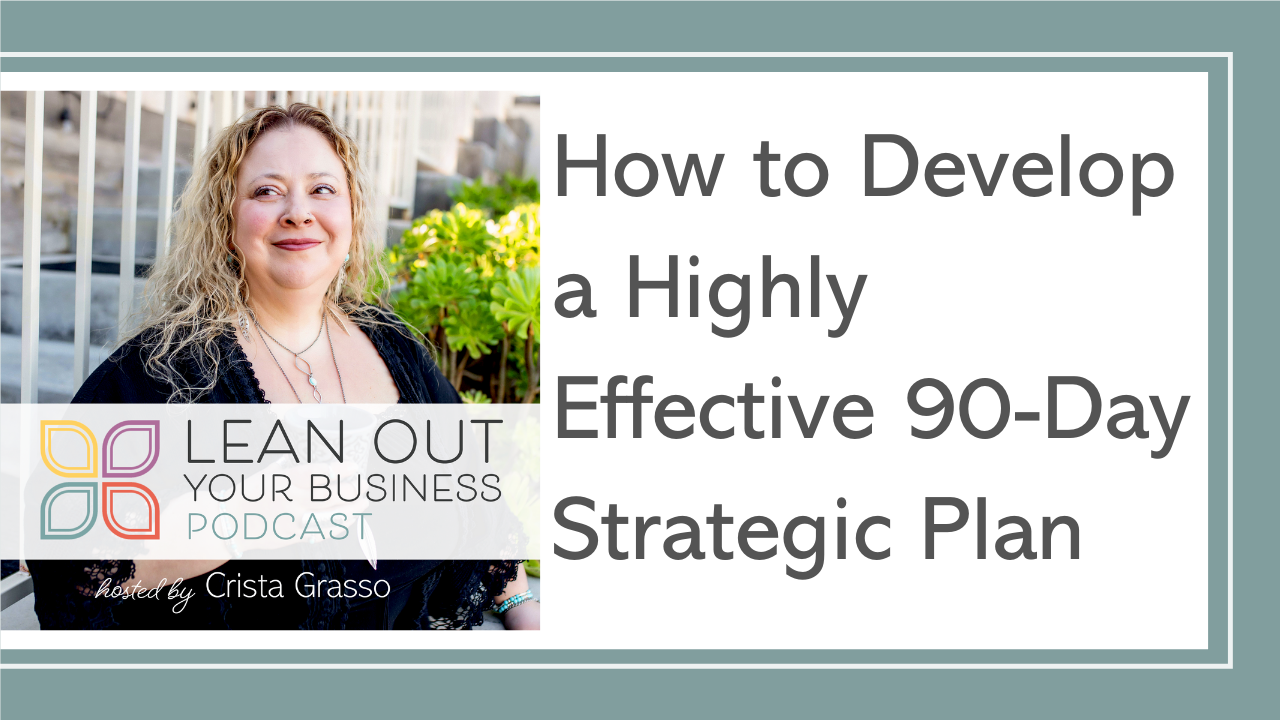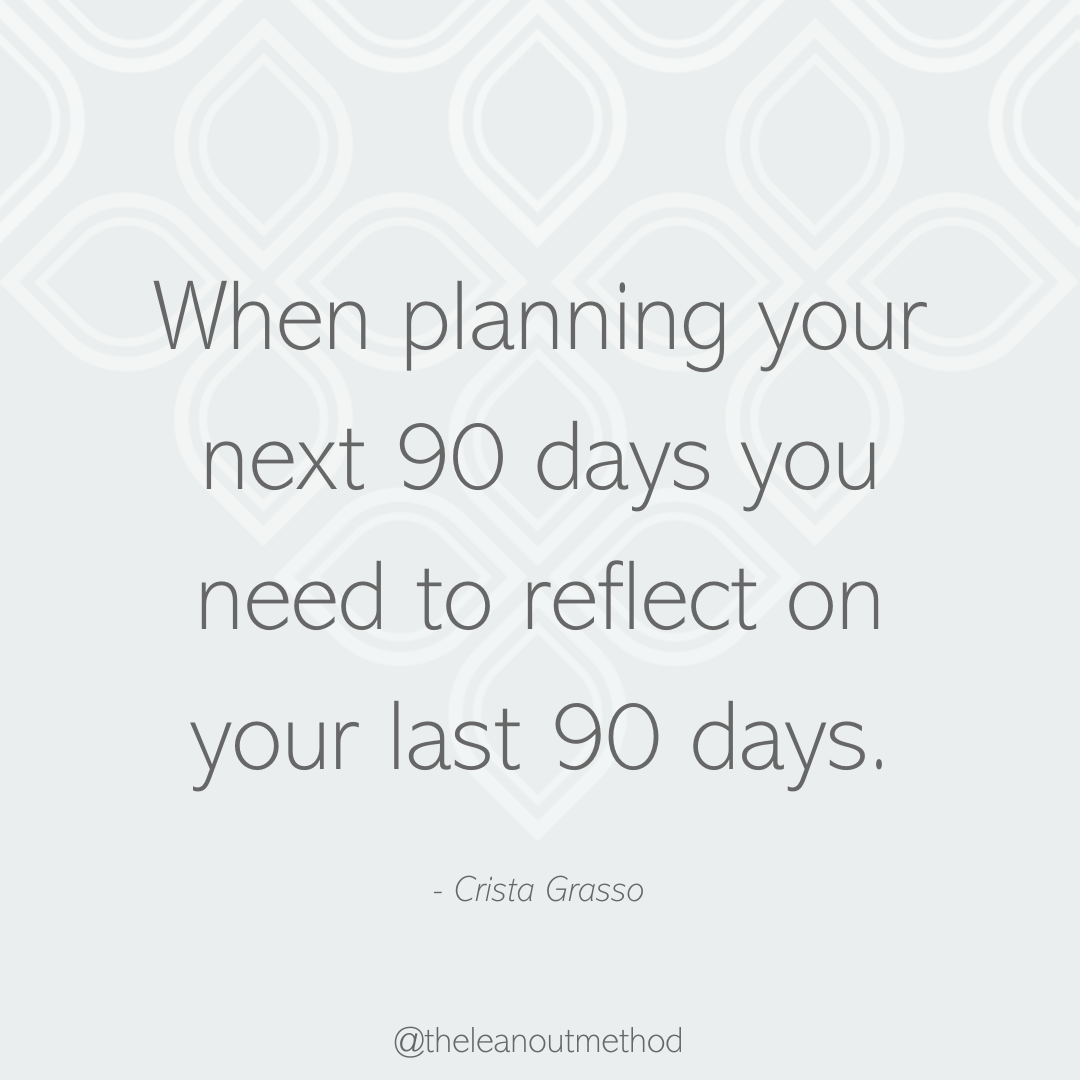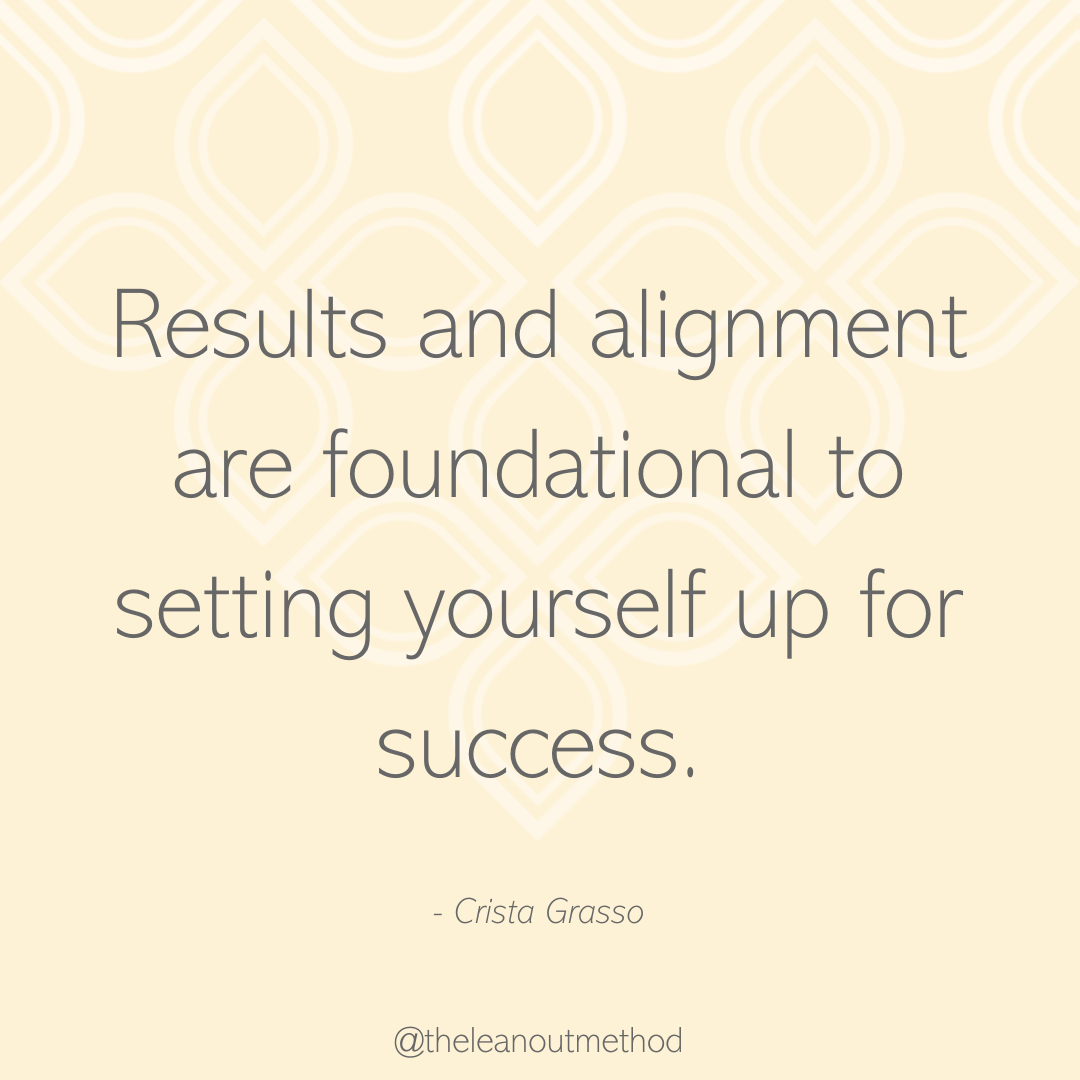
90 day planning and how to set yourself up for success for not only a brand new quarter but also for the second half of the year.
Even though it's all sunshine and summer vibes right now, the holidays will be here before we know it and now is the time to confirm what we are going to do when for the rest of the year.
- The most important thing to start with when planning
- How to ensure you have an alignment-focused plan
- Key questions to ask to set yourself up for success
- How to know when it's time to pivot your plan or offers
- How to gain clarity on the most important things to focus on
- How to leverage delegation so you can stay in your Zone of Genius
- How to develop a 6 month roadmap
- How to strategically plan your next 90 days
- Planning from a place of possibility
- Learn about enablers and how to use them in your business
Tune into Episode 26 of the Lean Out Your Business Podcast or keep reading below.
The most important thing to start with when planning your next 90 days is a reflection on your last 90 days (if you happen to read this going into the third quarter, I would recommend reflecting on the entire first half of the year, making sure you are on track and things are progressing the way you had planned at the beginning of the year; if they aren’t you can determine how you need to pivot so you can set yourself up for a successful end to the year).
"When planning your next 90 days, you need to reflect on your last 90 days." - Crista Grasso Click To Tweet
4 Questions to Ask Yourself and Your Team
As you begin your reflection period (either of the last 90 days or the last 6 months) there are four questions you can ask of yourself and of your team.
1. What are you most proud of/ what went really well?
2. Where are there lessons learned and things that didn’t go as well as you expected?
3. What do you want to continue/ do more of going into the new quarter/second half of the year?
4. What do you want to eliminate / do less of?
Questions 1 and 2 are important because they are focused on results. It’s during this period of reflection that we take time to celebrate what went really well in addition to the things that didn’t go as well as we excepted. Yes, that’s right. You can take time to celebrate what didn’t go well because you are celebrating what you learned from the experience and how that knowledge is going to fast-track your results going forward.
Questions 3 and 4 are just as important because they are focused on alignment. By taking time to look at what you want to keep doing and what you want to eliminate/do less of (aka lean out on) you are taking the time to make sure you are focused on the right things and that those things are in alignment with both your vision and goals for your business as well as your personal goals.
Results and alignment are foundational to setting yourself up for success.
"Results and alignment are foundational to setting yourself up for success." - Crista Grasso Click To Tweet
Taking time to reflect before planning for the next quarter is really helpful because often you will find that you need to pivot in order to set yourself and your team members up for success. If you can have a good handle on what’s working (and what’s not) before you plan your next 90 days, you’ll be able to keep things strategic keep things lean and avoid wasting time on things that don’t matter.
In addition to the four questions there are a few other things you will want to look at during this review period:
- Did you achieve your growth and sales goals?
- How are you progressing overall?
- Are there any changes you need to make for the next 90 days to account for where you are at currently?
This last question is also really important because it’s important to give an honest assessment of where you are at so you can know where you are going. Maybe you’re last 90 days were better than you ever imagined. In this case, do you need to adjust your goals for the next quarter to reflect that growth? Or on the other hand, maybe the last 90 days were a lot slower than anticipated, in this case, is there something you can do to make up for those sales in the next quarter or do you need to adjust your end of year goal based on the knowledge you now have?
Examining Your Offer Suite
When reviewing your last 90 days, in addition to looking at results and alignment you also want to do a deep dive into your offer suite as well as your actionable items to determine what’s working and what’s not.
If you are already running a lean business, you most likely don’t have too many offers but within every offer, every program, every sales funnel there could be room to lean out and remove certain aspects that are underperforming.
Some examples of places to look within your offer suite include:
- Your sales funnel – are there certain opt-ins that work better than others? Remove the ones that are underperforming
- Your online course– are there certain modules that everyone completes and others that people seem to get stuck on?
- Your mastermind – are there certain elements that people seem to get a lot of use out of and others that don’t seem to be utilized?
Another key area to examine is which of your offerings are most profitable? It’s important to remember that this might not be your biggest seller. Your biggest seller might bring in the most revenue but that doesn’t necessarily make it your most profitable item. When examining which item is your most profitable it’s important to consider things like, how much of your team’s time does an offer take to execute, how many resources do you need to deliver the service, how much money are you investing in advertising for the offer and how much of your own time are you investing in marketing the offer (i.e. podcast interviews, Instagram lives, etc.). You might find that you are actually investing more time into a lesser profit offer and if you switched your focus and attention to a more profitable item you (even if it has fewer sales now) you may end up with more revenue and more profit at the end of the year.
Once you know what offers are profitable and which ones are not you can begin to look for ways to increase the profitability of your lowest performers.
Optimized Activities
In a similar way to how you want to look at your offers to determine which are the most profitable you also want to take a look at all of your activities to determine which are the most optimized versus the least optimized.
A highly optimized activity is one that is automated and systematized, meaning you have the right systems and the right tools in place so that the person in charge of executing the activity knows precisely what to do so they can execute efficiently and receive consistent results.
The opposite of a highly optimized activity is one that is super manual. These activities take a lot of time, there’s a lot of variances and as a result, you don’t get consistent results. Another example of this type of activity is anything that’s on your plate that is not within your zone of genius.
It’s these low-optimized activities that have the most room for leaning out. And this is how:
- You can rearrange activities within your team so that these items that are not in your zone of genius are handed off to another team member, giving them the same opportunity to remove items from their plate that are not in their zone of genius
- You can implement my CHuCK technique:
- Cut – any activities that no longer serve you and your business
- Hold – put on hold any activities that you don’t have the bandwidth for
- Change – change the way an activity is being executed or who is executing it
- Keep as is – leave the activity alone
When you execute the CHuCK technique you are making sure that you are only working on the things that really matter to you and you’re making sure that everything that remains is effective, efficient and fully optimized (for more on this listen to Episode 12 of The Lean Out Your Business Podcast).
"CHuCK Technique: ( C ) CUT ( H ) HOLD ( C ) CHANGE ( K ) KEEP" - Crista Grasso Click To Tweet
Looking Forward
Now that we’ve reviewed the past 90 days (or 1st half of the year) it’s time to start looking forward to planning out the next 90 days (or the last half of the year).
As always, when you start planning for the future it’s important to revisit your vision, not your vision statement but your personal vision. This vision is three-faceted and should include: what you want for your business, what you want for yourself and your lifestyle and who your future customer is/ what they are going to need from you. (For more on Vision listen to Episode 22 of The Lean Our Your Business Podcast).
It’s important to make sure you review your vision first because it serves as a reminder of where you’re going; this is a good time to check in and see if you still want to go where you thought you did at the beginning of the year and it’s also a good time to assess if you are going to hit your goals by the end of the year.
In some cases, you might have already exceeded your vision and now is a good time to reimagine what is possible.
Setting Goals & Hitting Targets
Now that you are in love with your vision again, you’ve adjusted and confirmed that what you have envisioned is exactly where you want to go, it’s time to break that vision down intangible goals and tasks; it’s time to make the vision a reality.
I’m a very big believer that each 90-day period should only have 1 overarching goal to achieve. Yes, you will have lots of different tasks to complete, but there should only be one goal. When you are deciding on what goal you want to achieve this is when you should focus on how you want to feel. What will feel like a success to you? For example, you may want to stop feeling overwhelmed and begin to utilize capacity-based planning, meaning you will only say yes to tasks and activities that you know you can complete in the number of hours that you want to work.
Once you have an overarching goal for the 90-days you then set sales targets and growth targets.
In the same way that we have one overarching goal for the 90-days, I would encourage you to consider one growth channel over the same period. Wherever we focus our attention is where we see growth. Yes, you can still have multiple channels but in order to see the most growth, I would encourage you to go all-in, go deep into one channel, because what you focus on expands.
Connecting Strategy to Execution
You have a vision, you have your overarching goal and you have a channel you wanted to focus on, which means now it’s time to brainstorm all the ways you can achieve those goals and growth.
If you work with a virtual team, you can use Miro, an online whiteboard application, or if you are in person you can use good old-fashioned Post-it notes. Regardless of the tools you use, the idea is to brainstorm all the ways that you could achieve your goals. It’s important that in this stage you do not pre-edit yourself. Right now, you just want to build a backlog of all the ideas that could potentially get you the results you’re looking for.
It’s also important to remember that at this point, you are not committing to any of the ideas because you have to make your commitments with your capacity in mind.
6-Month Road Map
It’s time to Zoom out and start planning the next six months at a high-level view, defining the top priorities for each coming month, but not worrying about having all the details figured out. At this point, you’ll want to simply define what you know. Things that go on your six-month road map include:
- Events
- Commitments
- Holiday promotions
- Projects (i.e. building a website, launching a deadline, building a new tool)
- Marketing campaigns
Knowing what’s coming in the future can help us determine what our enablers are for today. Enablers are anything you need to be doing now, in order to execute anything effectively in the future.
For example, we have our Lean Out, Level Up Retreat in January 2022. There are certain things I need to do now (book a venue, hire caterers, etc.) in order for the retreat to be a success. These are enablers.
Building Your 90 Day Plan
By now you should have:
- Reviewed the past 90 days/6 months
- Reviewed and refined your vision
- Set an overarching goal/goals and sales/growth targets
- Strategized all possible ways to execute and achieve your goals
- Created a 6-month road map
With the hard work behind you it’s time to review your notes and create your 90-Day Plan. Your plan should include:
- Major projects and marketing campaigns that you are going to get done and to the best of your knowledge when you are going to get them done by
- Growth and sales targets
- Overall goal(s) for the quarter
- What will make the next 90-days feel like a success
- What you can realistically (keyword, being realistically) get done in 90-Days
Now you take a confidence vote (ideally with your team) and on a scale of 1 to 5 (1 being very unconfident and 5 being very confident), how confident do you feel that you can execute the plan? If you score a 3 or below, you need to go back and revisit the plan because it’s important that you and your team have confidence that your plan is achievable and that the right things will be getting done to get the right results.

"Break your vision down into tangible goals and tasks." -Crista Grasso Click To Tweet
Mindset
There’s one final thing I want to mention and it’s this: in order to achieve your vision and goals you are going to have to work on your mindset. It’s very normal that as we try to achieve things we’ve never done before that the mindset gremlins pop up, reminding us of past habits and all the reasons we “can’t” do something. You are capable of bringing your dreams to life. You are capable of designing and executing a strategic plan.
If you want help on the journey there are two ways, we can work together on building a strategic plan: 1-day business intensives and private coaching. If you are interested in learning more about either you can visit me at chatwithcrista.com. Get on my calendar and we can if either of these programs would be a good fit for you and your team.
by Crista Grasso
Crista Grasso is the go-to strategic planning expert for leading global businesses and online entrepreneurs when they want to scale. Known as the "Business Optimizer", Crista has the ability to quickly cut through noise and focus on optimizing the core things that will make the biggest impact to scale a business simply and sustainably. She specializes in helping businesses gain clarity on the most important things that will drive maximum value for their clients and maximum profits for their business. She is the creator of the Lean Out Method, 90 Day Lean Out Planner, and host of the Lean Out Your Business Podcast.







